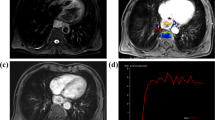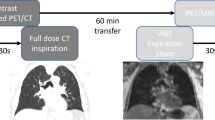Abstract
Objectives
To investigate the feasibility and diagnostic value of free-breathing, radial, stack-of-stars three-dimensional (3D) gradient echo (GRE) sequence (“golden angle”) on dynamic contrast-enhanced (DCE) MRI of gastric cancer.
Methods
Forty-three gastric cancer patients were divided into cooperative and uncooperative groups. Respiratory fluctuation was observed using an abdominal respiratory gating sensor. Those who breath-held for more than 15 s were placed in the cooperative group and the remainder in the uncooperative group. The 3-T MRI scanning protocol included 3D GRE and conventional breath-hold VIBE (volume-interpolated breath-hold examination) sequences, comparing images quantitatively and qualitatively. DCE-MRI parameters from VIBE images of normal gastric wall and malignant lesions were compared.
Results
For uncooperative patients, 3D GRE scored higher qualitatively, and had higher SNRs (signal-to-noise ratios) and CNRs (contrast-to-noise ratios) than conventional VIBE quantitatively. Though 3D GRE images scored lower in qualitative parameters compared with conventional VIBE for cooperative patients, it provided images with fewer artefacts. DCE parameters differed significantly between normal gastric wall and lesions, with higher Ve (extracellular volume) and lower Kep (reflux constant) in gastric cancer.
Conclusions
The free-breathing, golden-angle, radial stack-of-stars 3D GRE technique is feasible for DCE-MRI of gastric cancer. Dynamic enhanced images can be used for quantitative analysis of this malignancy.
Key Points
• Golden-angle radial stack-of-stars VIBE aids gastric cancer MRI diagnosis.
• The 3D GRE technique is suitable for patients unable to suspend respiration.
• Method scored higher in the qualitative evaluation for uncooperative patients.
• The technique produced images with fewer artefacts than conventional VIBE sequence.
• Dynamic enhanced images can be used for quantitative analysis of gastric cancer.



Similar content being viewed by others
Abbreviations
- AUC:
-
Area under the curve
- BH:
-
Breath-hold
- CNR:
-
Contrast-to-noise ratio
- CT:
-
Computed tomography
- DCE:
-
Dynamic contrast-enhanced
- FB:
-
Free-breathing
- GRE:
-
Gradient echo
- Kep:
-
Extravascular-to-plasma volume transfer
- Ktrans:
-
Plasma-to-extravascular volume transfer
- MDCT:
-
Multiple-detector computed tomography
- MRI:
-
Magnetic resonance imaging
- ROI:
-
Region of interest
- SD:
-
Standard deviation
- SI:
-
Signal intensity
- SNR:
-
Signal-to-noise ratio
- Ve:
-
Extravascular fluid volume fraction
- VIBE:
-
Volume-interpolated breath-hold examination
References
Ferlay J, Soerjomataram I, Dikshit R et al (2015) Cancer incidence and mortality worldwide: sources, methods and major patterns in GLOBOCAN 2012. Int J Cancer 136:E359–E386
Chen W, Zheng R, Baade PD et al (2016) Cancer statistics in China, 2015. CA Cancer J Clin 66:115–132
Imaging Technology Branch and Radiology Branch of Chinese Medical Association (2016) Expert consensus about MRI examination technology. Chin J Radiol 50:724–739
Block KT, Chandarana H, Milla S et al (2014) Towards routine clinical use of radial stack-of-stars 3D gradient-echo sequences for reducing motion sensitivity. J Korean Soc Magn Reson Med 18:87–106
Winkelmann S, Schaeffter T, Koehler T, Eggers H, Doessel O (2007) An optimal radial profile order based on the Golden Ratio for time-resolved MRI. IEEE Trans Med Imaging 26:68–76
Othman AE, Martirosian P, Schraml C et al (2015) Feasibility of CAIPIRINHA-Dixon-TWIST-VIBE for dynamic contrast-enhanced MRI of the prostate. Eur J Radiol 84:2110–2116
Kim KW, Lee JM, Jeon YS et al (2013) Free-breathing dynamic contrast-enhanced MRI of the abdomen and chest using a radial gradient echo sequence with K-space weighted image contrast (KWIC). Eur Radiol 23:1352–1360
Joo I, Lee JM, Kim JH, Shin CI, Han JK, Choi BI (2015) Prospective comparison of 3T MRI with diffusion-weighted imaging and MDCT for the preoperative TNM staging of gastric cancer. J Magn Reson Imaging 41:814–821
Liu S, Wang H, Guan W et al (2015) Preoperative apparent diffusion coefficient value of gastric cancer by diffusion-weighted imaging: correlations with postoperative TNM staging. J Magn Reson Imaging 42:837–843
Yamada I, Miyasaka N, Hikishima K et al (2015) Gastric carcinoma: ex vivo MR imaging at 7.0 T—correlation with histopathologic findings. Radiology 275:841–848
Ma L, Xu X, Zhang M et al (2017) Dynamic contrast-enhanced MRI of gastric cancer: correlations of the pharmacokinetic parameters with histological type, Lauren classification, and angiogenesis. Magn Reson Imaging 37:27–32
O'Connor JP, Jackson A, Parker GJM, Jayson GC (2007) DCE-MRI biomarkers in the clinical evaluation of antiangiogenic and vascular disrupting agents. Br J Cancer 96:189–195
Teo QQ, Thng CH, Koh TS, Ng QS (2014) Dynamic contrast-enhanced magnetic resonance imaging: applications in oncology. Clin Oncol (R Coll Radiol) 26:e9–e20
Turkbey B, Thomasson D, Pang Y, Bernardo M, Choyke PL (2010) The role of dynamic contrast-enhanced MRI in cancer diagnosis and treatment. Diagn Interv Radiol 16:186–192
Consolino L, Longo DL, Sciortino M (2017) Assessing tumor vascularization as a potential biomarker of imatinib resistance in gastrointestinal stromal tumors by dynamic contrast-enhanced magnetic resonance imaging. Gastric Cancer 20:629–639
Li L, Wang K, Sun X, Sun Y, Zhang G, Shen B (2015) Parameters of dynamic contrast-enhanced MRI as imaging markers for angiogenesis and proliferation in human breast cancer. Med Sci Monit 21:376–382
Kershaw LE, Cheng HL (2010) Temporal resolution and SNR requirements for accurate DCE-MRI data analysis using the AATH model. Magn Reson Med 64:1772–1780
Chandarana H, Feng L, Block TK et al (2013) Free-breathing contrast-enhanced multiphase MRI of the liver using a combination of compressed sensing, parallel imaging, and golden-angle radial sampling. Invest Radiol 48:10–16
Feng L, Grimm R, Block KT et al (2014) Golden-angle radial sparse parallel MRI: combination of compressed sensing, parallel imaging, and golden-angle radial sampling for fast and flexible dynamic volumetric MRI. Magn Reson Med 72:707–717
Joo I, Lee JM, Han JK, Yang HK, Lee HJ, Choi BI (2015) Dynamic contrast-enhanced MRI of gastric cancer: Correlation of the perfusion parameters with pathological prognostic factors. J Magn Reson Imaging 41:1608–1614
Jena A, Taneja S, Singh A, Negi P, Mehta SB, Sarin R (2017) Role of pharmacokinetic parameters derived with high temporal resolution DCE MRI using simultaneous PET/MRI system in breast cancer: a feasibility study. Eur J Radiol 86:261–266
Gao P, Shi C, Zhao L, Zhou Q, Luo L (2016) Differential diagnosis of prostate cancer and noncancerous tissue in the peripheral zone and central gland using the quantitative parameters of DCE-MRI: a meta-analysis. Medicine (Baltimore) 95:e5715
Fujinaga Y, Ohya A, Tokoro H, Yamada A, Ueda K et al (2014) Radial volumetric imaging breath-hold examination (VIBE) with k-space weighted image contrast (KWIC) for dynamic gadoxetic acid (Gd-EOB-DTPA)-enhanced MRI of the liver: advantages over Cartesian VIBE in the arterial phase. Eur Radiol 24:1290–1299
Hao W, Zhao B, Wang G, Wang C, Liu H (2015) Influence of scan duration on the estimation of pharmacokinetic parameters for breast lesions: a study based on CAIPIRINHA-Dixon-TWIST-VIBE technique. Eur Radiol 25:1162–1171
Funding
This study has received funding by the innovation funds for development of science and technology in PuDong new area, Fund code: PKJ2013-Y07
Author information
Authors and Affiliations
Corresponding author
Ethics declarations
Guarantor
The scientific guarantor of this publication is Wei-jun Peng.
Statistics and biometry
One of the authors has significant statistical expertise.
Informed consent
Written informed consent was obtained from all patients in this study.
Ethical approval
Institutional Review Board approval was obtained.
Methodology
• prospective
• performed at one institution
Rights and permissions
About this article
Cite this article
Li, HH., Zhu, H., Yue, L. et al. Feasibility of free-breathing dynamic contrast-enhanced MRI of gastric cancer using a golden-angle radial stack-of-stars VIBE sequence: comparison with the conventional contrast-enhanced breath-hold 3D VIBE sequence. Eur Radiol 28, 1891–1899 (2018). https://doi.org/10.1007/s00330-017-5193-1
Received:
Revised:
Accepted:
Published:
Issue Date:
DOI: https://doi.org/10.1007/s00330-017-5193-1




